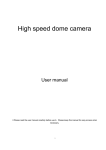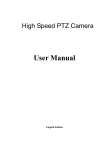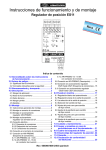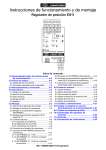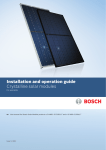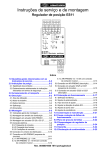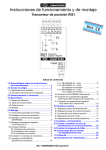Download Sharp QSINUFO Operating instructions
Transcript
Operating Instructions Network Camera Operating Instructions QSINUFO ` 1 Operating Instructions Please read this manual before using and save this manual for future reference. Introduction Please check the following items when unpacking. AC adaptor — 1 pc. I/O port link line — 1 pc. Category 5 cross cable — 1 pc. Setup CD-ROM — 1 pc. Operating Instructions — 1 pc. Trademarks ¾ Netscape and Netscape Navigator are registered trademarks of Netscape Communications Corporation in the U.S. and other countries. ¾ Adobe and Acrobat are either registered trademarks or trademarks of Adobe Systems Incorporated in the United States and/or other countries. ¾ Microsoft, Windows, Windows NT, MS-DOS and ActiveX are either registered trademarks or trademarks of Microsoft Corporation in the United States and/or other countries. ¾ Pentium is a registered trademark of Intel Corporation or its subsidiaries in the United States and other countries. All other trademarks identified herein are the property of their respective owners. 2 Operating Instructions Table of Contents 1. Product Introduction ............................................................ 4 1.1 Getting to know the Network Camera.............................................................................4 1.1.1 Main features............................................................................................................4 1.1.2 System Requirements...............................................................................................5 1.2 Camera Feature Locations...............................................................................................5 1.2.1 Front View................................................................................................................5 1.2.2 Rear View.................................................................................................................6 1.3 Network Camera Installation ..........................................................................................6 1.3.1 Connecting the Cable and the Power Supply ...........................................................6 1.3.2 Confirming the Network Camera Setting.................................................................8 1.3.3 Setting Network Parameters.....................................................................................8 Use reset key .....................................................................................................................9 1.3.4 Use ARP command ..................................................................................................9 2. Network Camera Screen and Setup window.................... 11 2.1 Network Camera View Image ....................................................................................... 11 2.2 Viewing the Top View Image screen.............................................................................12 2.3 Setup window—System Configuration.........................................................................13 System Configuration..................................................................................................14 2.3.1 Network..................................................................................................................16 2.3.2 Date/Time...............................................................................................................18 2.3.3 Administrator..........................................................................................................19 2.3.4 General User...........................................................................................................20 2.3.5 Video Settings ........................................................................................................21 2.3.6 Multi-server............................................................................................................22 2.3.7 I/O Ports .................................................................................................................23 2.3.8 Timer Capture.........................................................................................................24 2.3.9 Motion Detect.........................................................................................................25 2.3.10 Constant Recording..............................................................................................26 2.3.11 Event Manage.......................................................................................................27 2.3.12 Event Picture ........................................................................................................28 2.3.13 Event Properties ...................................................................................................29 3 Operating Instructions 2.3.14 PTZ Control Settings............................................................................................30 2.3.15 Other settings .......................................................................................................31 5. Technical Guides ............................................................. 34 3.1 Maintenance ..................................................................................................................34 3.2 Interfacing to the I/O Connector ...................................................................................34 3.3 I/O .................................................................................................................................34 1. I/O ...............................................................................................................................34 2.COMM .........................................................................................................................35 3.switch ...........................................................................................................................36 6. Specifications and Troubleshooting............................... 37 6.1 Network Camera reset procedure—default settings................................................37 6.2 Specification............................................................................................................37 6.3 Troubleshooting ......................................................................................................39 4.4 Important Safety Instruction..........................................................................................40 1. Product Introduction 1.1 Getting to know the Network Camera 1.1.1 Main features ¾ Using the Network Camera integrated web server, Motion JPEG, up to 15 frames per second, can be displayed. ¾ Pan/Tilt operation can move the lens horizontally 120° and downside 45°. This movable lens allows you to see the situation in the wide room where the object is. It can adjust the angle easily from the web browser. ¾ Using Multi-Camera screen you can simultaneously view up to four cameras at various location. Clicking on each Camera Name switches to the Single Camera screen from the Multi-Camera screen. ¾ The Network Camera allows the 15 users to view the image simultaneously. ¾ Authentication window requires you to enter the administrator/general user ID and password. ¾ I/O connector consists of the digital input/output terminal. The alarm/timer trigger can activate the Image Transfer feature which can send the images via e-mail or FTP (File Transfer Protocol). 4 Operating Instructions 1.1.2 System Requirements The PC and the network must meet the following technical specifications for the Network Camera to work properly. Item Description Operating System Microsoft Windows 98 Microsoft Windows 2000, Microsoft Windows ME Microsoft Windows NT® 4.0, Microsoft Windows XP Network Protocol TCP/IP network protocol installed. (HTTP, FTP, SMTP, TCP, UDP, IP, ARP, ICMP) CPU Pentium® II 300 MHz or greater Interface 10/100 Mbps Ethernet card and category 5 cables for your network connection Web Browser Internet Explorer 5.0 or later/Netscape Navigator® 4.7 1.2 Camera Feature Locations 1.2.1 Front View Power Indicator: During normal operation Power Indicator will be turned on in the default. Blinking will occur during the following situation. Audio input port. 5 Operating Instructions 1.2.2 Rear View From left to right: RJ45: 100 Base-T:Ethernet Indicator I/O:Including two I/O inputs and two I/O outputs. COMM port: including one RS-232 and one RS-485and one LINE OUT。 BNC port: video output. Reset key DC IN jack: 12v 1A Switch: BLC, IRIS, AGC, AWB 1.3 Network Camera Installation This section explains how you can install the Network Camera. Network Camera has a integrated web server. Various types of networking are available. 1.3.1 Connecting the Cable and the Power Supply 1.Connection of the Network Camera to the PC or network device is made with category 5 cable. 6 Operating Instructions 2.Hub Connection needs category 5 straight cable and PC Connection needs category 5 cross cable. 3.LAN (Intranet)、Internet Connection with Ethernet Switching Hub Network Camera can be installed on the LAN. Network Camera can be accessed through the Internet. 7 Operating Instructions 1.3.2 Confirming the Network Camera Setting To confirm if the Network Camera is configured correctly, please access to Top Page. If the Top Page appears, your Network Configuration is completed. 1. Start up the web browser. 2. Enter "http://IP address : Port No." in the address field and press [Enter]. Top Page appears. 1.3.3 Setting Network Parameters IP Network: PC, Network Camera and other IP devices can establish the network. Each device has an unique IP address of their own.. Note MAC address Ethernet defines a 48-bit addressing scheme. Ethernet hardware manufacturers purchase blocks of Ethernet addresses and assign them in sequence to their Ethernet interface hardware. No two hardware interfaces have the same Ethernet address. Ethernet address is sometimes called hardware addresses, physical addresses, Media Access Control (MAC) addresses, or layer 2 addresses. MAC address is used in this manual. ActiveX Controls If you are using Internet Explorer the first time the PC connects to the Network Camera, a pop up Security Warning window will appear. The window requests your 8 Operating Instructions permission to download ActiveX Controls (OCX file) used to display motion video. Please allow the file to be installed. It is required and will not cause any problems with other applications on the PC. Use reset key IP will be changed to 192.168.1.252. Blinking will occur during the following situation. Press reset key until the electrical source blinking. 1.3.4 Use ARP command Attention before assign IP: Confirm the network camera connected the web correctly, then cut off the power. Get a single IP address from network manager MAC address: Each Ball network camera has a single MAC address, MAC address is a 12byte figure, it is singed on the bottom of the Ball camera.(such as 000ce8xxxxxx ) In the following example, the PC IP address is 192.168.1.6, the IP address of BALL Network camera is assigned 192.168.1.61, MAC address is 000ce8000001, Do not use the IP address demonstrated here, please consult with network manager before you assign the IP address. The IP address of BALL Network Camera must have the same subnet mask with PC. In this example, the IP of PC is 192.168.1.6,the IP of network camera is 192.168.1.61, subnet mask is 255.255.255.0 , if the subnet mask of PC is 255.255.255.128 or more high, C:\>exit 9 Operating Instructions C:\>arp -d C:\>arp -s 192.168.1.61 00-0c-e8-00-00-01 C:\>ping -t 192.168.1.61 Pinging 192.168.1.61 with 32 bytes of data: Request timed out. Request timed out. Request timed out. Reply from 192.168.1.61: bytes=32 time=5ms TTL=255 Reply from 192.168.1.61: bytes=32 time=4ms TTL=255 Reply from 192.168.1.61: bytes=32 time=4ms TTL=255 Reply from 192.168.1.61: bytes=32 time=4ms TTL=255 Ping statistics for 192.168.1.61: Packets: Sent = 7, Received = 4, Lost = 3 (42% loss), Approximate round trip times in milli-seconds: Minimum = 4ms, Maximum = 5ms, Average = Control-C ^C C:\>arp -d 10 2ms Operating Instructions 2. Network Camera Screen and Setup window 2.1 Network Camera View Image The view image enables you to access to the Top View Image screen (Single Camera/Multi-Camera screen). Authentication window can set password for the link at. 11 Operating Instructions 1. View Image Single Camera / Multi-Camera 2. System Configuration 3. Help 4. Language : English Chinese . 2.2 Viewing the Top View Image screen The Top View Image screen consists of Single Camera and Multi-Camera screen. Single Camera screen Item 12 Description Operating Instructions Brightness Saturation Volume Iris Resolution Image quality Brightness control has 17 steps including Saturation control has 9 steps including Volume control has 10 steps including Adjust Iris Selects 640X 480, 320X240 (default) or 160X120. Favor clarity/Standard/Favor motion 2.3 Setup window—System Configuration Setup Page controls all features of the Network Camera. The authentication window can keep the network security. It enables only administrator to access the Setup Page by entering ID and Password. 13 Operating Instructions User: admin Password: admin System Configuration 14 Operating Instructions Network Date/Time Administrator General User Picture/voice Basic Setup Multi-Server Configures the network setting Sets the network Date and Time Sets administrator ID and password for the security. Sets General User ID and password for the security. Setup image compression ration, voice input gain and select OCX. Setup Multi-Server Setup the alarm occur condition and the I/O port output ports status. Timer Setup eight timers of alarm timer. Motion Detect Constant Recording Constant recording Event Manage Event Manage Picture Viewer Constant recording to Ftp Server. There are three modes: I/O ports occur, timer occur and motion detection occur. Show the event picture, alarm type. alarm id and alarm time. 15 Operating Instructions Event Viewer PTZ Others PTZ Restart Reset Setting System information Update firmware Language Show the event properties: message type and alarm type, ID, time. PTZ control settings. Restart the network camera. Reset the video server form factory default. Show system information. Update the system. You can select Chinese or English. language 2.3.1 Network Network window can set up the each parameter. Please restart the Network Camera when making the parameters effective. 16 Operating Instructions Network Name Port No. IP Address and Subnet Mask DHCP Default Gateway DNS DDNS 4 to 15 English letters,2 to 7 Chinese characters Set to 80. (Default) Check Static and set Static IP address and Subnet Mask. Please check DHCP when the ISP uses the DHCP server function that assigns an IP address to the Network Camera automatically. IP Gateway Enter it in gateway IP.. PPPOE Gateway Enter it in PPPOE user name and password. You must enter the proper address when use the Host name of the e-mail or FTP function. Network Camera log in management server of network camera to brows Manage Server after input user name and password. DDNS input domain name to directly remote brows after input user name and password and free domain name . Max. Bandwidth Usage It can restrict the transmit bandwidth. Select from 0.1 to Unlimited Mbit/s. MAC 17 Operating Instructions 2.3.2 Date/Time Item Instructions 1.Date and Time Display current Camera date and time. 2.Set Network Camera Date and Time Network Camera can adjust the internal clock. (1)Synchronize Current With Computer Time Make the Network Camera the internal clock together current the calculator clock is synchronous Limitation • (2) Set Manually 18 Set time to adjust the internal clock. • The date is from 1970 to 2039 , according to yyyy- mm- dd. Time is format that 24 hours system, according to hh: mm: ss. Operating Instructions 2.3.3 Administrator Administrator window allows the administrator to limit or exclude the access to selected Network Camera feature. Individual levels of access can be defined for multiple users. The administrator can select one of three security levels: [None] [Administrator only]: Setup Page for Administrator only [Administrator and General User]: Setup Page for Administrator and Viewer Page for General User 19 Operating Instructions 2.3.4 General User General User window allows the administrator to create the General User ID and password for the security level defined as General User. User Name List: User Name List displays the registered user name.[Delete] and [Modify] deletes/modifies the General User in the list. New User: Enter the General User Name, password to confirm. 20 Operating Instructions 2.3.5 Video Settings [Video Adjust ]: Permit General User adjust. [Header Display]: Display the network camera name, date and time. [Image Mirror]:you can browse the image like look into the mirror. [BLC Control]:enable BLC. [White Balance]: Auto (default)、Electric Bulb、Natural fluorescent light、Solar light、 Hold. [Compression Ratio]: Compress the image and the ratio. [Voice Input Gain]: you can adjust the volume. there are 10 steps including. [OCX select]: select ActiveX or Java applet. 21 Operating Instructions 2.3.6 Multi-server Multi-Camera window enables the setting of Multi-Camera screen. 2nd to 4th cameras are named on this Multi-Camera window. 22 Operating Instructions 2.3.7 I/O Ports Setup alarm occur condition: when the electricity falling. when the electricity rising. output ports status :high impedance and low impedance. output port status keep live times. 23 Operating Instructions 2.3.8 Timer Capture The timer mode can be activated by entering the every week. 24 active time. You can set eight timers of Operating Instructions 2.3.9 Motion Detect Setup the alarm scope of motion detection. 25 Operating Instructions 2.3.10 Constant Recording [Constant Recording]: Permit constant recording or not. [Image Setting]: Set the image resolution and image quality. Image resolution: 640 x 480/320 x 240/160 x 120 Image quality: Favor Clarity/Standard/Favor Motion [Image Frequency]: Sets the interval to send the image. [FTP Server]: Enters the server address or Host Name, Port no. (1–65535), Login ID and password to access the FTP server and upload file name including full path. [Notification to be sent when record fail]: when constant recording fail, send the message to the SMTP Server. 26 Operating Instructions 2.3.11 Event Manage [Event Source Select]:I/O port Occur Transfer in the Alarm Mode Timer Occur Transfer in the Timer Mode Motion Detection Occur The Alarm mode and the motion detection mode can transfer the image via e-mail or FTP when the alarm trigger is active. To activate the alarm trigger, the digital input terminal of the I/O Connector must be connected with the external sensors/devices. The Alarm mode can send the e-mail without transferring the image. The timer mode can be activated by entering the active time, the image setting, frequency setting and the transfer method on the Image Transfer window. Buffered Image can also be transferred via e-mail or FTP. 27 Operating Instructions [Image Setting]: Set the image resolution Image resolution: 640 x 480/320 x 240/160 x 120 [Image Buffer Setting]: [Over Buffer Setting]:over write the buffer or not when the buffer is full. [FTP Server]: Enters the server address or Host Name, Port no. (1–65535), Login ID and password to access the FTP server and upload file name including full path. [SMTP Server]: SMTP Server IP address or host name: Sets the SMTP server address or Host Name. From (Reply): Enter the e-mail address of [Reply-to]. [To] can be the same address as From (Reply). To : Enter the e-mail address of receiver. Subject & Text : Sets the subject and text of the e-mail. [Network Camera Manager Server]:set the manager server IP address or name . 2.3.12 Event Picture Show the event picture. 28 Operating Instructions 2.3.13 Event Properties Show the event properties. Message type ,alarm type , alarm id and alarm time. 29 Operating Instructions 2.3.14 PTZ Control Settings [PTZ Control]: Permit General User control or not. [COM Settings]: Sets baud rate. [PTZ Control Identity]: Sets PTZ ID. [Select PTZ Control Driver]: Select PTZ protocols. 30 Operating Instructions 2.3.15 Other settings Restart the network camera. 31 Operating Instructions Reset the video server form factory default. The IP will be changed to 192.168.1.252. Show the system information: firmware version and software version.. 32 Operating Instructions Select the language : Chinese or English. 33 Operating Instructions 5. Technical Guides 3.1 Maintenance To keep the Network Camera in the good condition, maintenance plays an important part. Please keep maintenance when using the Network Camera. Network Camera • Network Camera is intended for indoor use only. Prolonged exposure to direct sunlight or halogen light may damage the CMOS sensor. The Fixed Focused lens • Do not touch the movable lens part around the Fixed Focus Lens even in the power off state. If you touch the movable lens part in the front of the Network Camera, it may damage the Network Camera. • Do not touch the Fixed Focus Lens. It may leave a fingerprint and can cause the image to be out of focus. This can also take away the protective coating on the Fixed Focus Lens. • Clean the lens with a Lens Cleaning paper. 3.2 Interfacing to the I/O Connector The Alarm mode in the Image Transfer feature requires the external sensors/devices to be connected to the digital input terminal of the I/O Connector. The sensor is customer provided and can be a door sensor or infrared ray intruder sensor. In most applications a simple contact closure is all that is required. 3.3 I/O 1. I/O I/O ports have two I/O inputs and two I/O outputs 34 Operating Instructions Explanation of I/O Connector: Pin Function 1 I/O-IN 2 I/O-OUT 3 +12V 4 DGND 5 I/O-IN 6 I/O-OUT (1) (1) (<100mA) (2) (2) 2.COMM COMM ports have one RS-232 , RS-485 and one LINE OUT。 35 Operating Instructions Explanation of COMM Connector:: Function PIN 232/(RXD UFO-II-H Å) DGND 1 2 4 232/(TXD UFO-II-H Æ) DGND 5 LINE OUT 6 AGND 7 485/(B UFO-II-H Å) 8 485/(A UFO-II-H Æ) 3 3.switch Explanation of Connector:: Pin 36 Function 1 BLC 2 IRIS 3 AGC Operating Instructions 4 AWB 4. LENS 2 1 4 3 Explanation of Connector:: No. 名称 1 DAMP- 2 DAMP+ 3 DRIVE+ 4 DRIVE- 6. Specifications and Troubleshooting 6.1 Network Camera reset procedure—default settings If the user forgets the settings or passwords, the Network Camera can be easily reset to the default settings. 6.2 Specification 37 Operating Instructions Item Network Protocols TCP/IP, HTTP, FTP, SMTP, DDNS, DNS,DHCP, PPPOE Network Connection MODEM、ISDN、XDSL、LAN CPU 32 bits,RISC CPU FLASH 4MB RAM 32M Operation system Embedded real time operation system Image Compression JPEG, MOTION-JPEG System Requirements Microsoft IE, Netscape Performance 25(SIF),15(VGA) Resolution 640×480,320×240,160×120 Alarm image buffer 80frames Event trigger & Action I/O ports 38 UFO-Ⅱ-L network camera I/O Trigger,timer Trigger,motion detection 2 I/O in & 2 I/O out indoor/outdoor indoor Audio(optional) G.711,G.726,G.723.1,G.729 Sensor 1/3,SHARP, CCD plane definition 480 line LUX 1.0 Lux(F1.2) Operating Instructions • • • • • Video control • • AWB: White Balance (ATW/Push/Indoor/Outdoor) AGC: Automatic Gain Control (On/Off) Manual Electronic Shutter (1/50 or 1/60 when AES off) Auto DC IRIS Auto Electronic Shutter (AES on/off, BLC on/off) Day/Night feature (Color/B.W. auto switch in low illumination) BLC: Back light compensation Direct Drive Lens; Build-in VR for DC level adjustment LENS Auto DC Iris F1.2~64 Lens Serial port One RS-232 Serial port P/T/Z One RS-485 Serial port for PTZ camera control Size 110X102X54mm(expect bracket) Power supply 12DC/4W Operating Temperature (-20℃)——(+50℃) 6.3 Troubleshooting Problem Cause and Remedy 39 Operating Instructions When the Top Page does • Enter the correct IP address set up to the Network not appear. Camera. • IP address of the PC and the Network Camera must be in the same class of the private IP address on the LAN. • Confirm if the Ethernet, the hub and the LAN card indicators are on. If any indicator is off, check the network connections. • The network congestion prevents the Top Page from appearing quickly. Please wait for a while. • The proxy server may prevent you from connecting directly to the Network Camera, please set up not to use the proxy server. When forgetting the 1. Reset the Network Camera by pressing the CLEAR password to access the SETTING button. Setup Page. 2. Reconfigure the Network Camera. 4.4 Important Safety Instruction When using this unit, basic safety precautions should always be followed to reduce the risk of fire, electric shock, or personal injury. a) Read and understand all instructions. b) Unplug this unit from AC outlets before cleaning. Do not use liquid or aerosol cleaners. Use a damp cloth for cleaning. c) Do not use this unit near water, for example, near a bathtub, washbowl, kitchen sink, or the like. d) Place this unit securely. Serious damage and/or injury may result if the unit falls. e) Use proper power source. If you are not sure of the type of power supplied to your home, consult your dealer or local power company. f) Do not place objects on the power cord. Install the unit where no one can step or trip on the cord. g) To reduce the risk of electric shock, do not disassemble this product, but take it to a qualified serviceman when some service or repair work is required. Opening or removing covers may expose you to dangerous voltage or other risks. Incorrect reassembly can cause electric shock when the appliance is subsequently used. h) Unplug this unit from the wall outlet and refer servicing to an authorized serviette when the following conditions occur: 1) When the power supply cord or plug is damaged or frayed. 2) If liquid has been spilled into the unit. 40 Operating Instructions 3) If the unit has been exposed to rain or water. 4) If the unit does not work normally by following the operating instructions. 5) If the unit has been dropped or physically damaged. 6) If the unit exhibits a distinct change in performance. WARNING TO PREVENT RISK OF FIRE OR ELECTRIC SHOCK, DO NOT EXPOSE THIS PRODUCT TO RAIN OR MOISTURE. 41










































